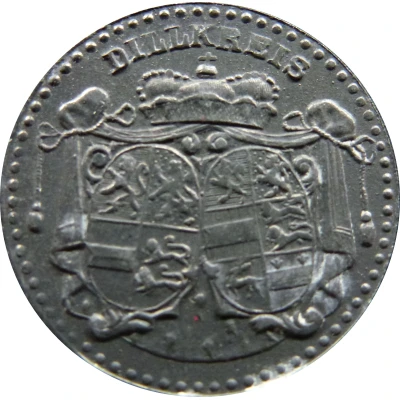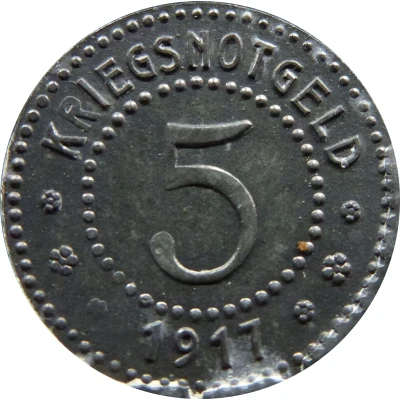


© Willem63 (CC BY-NC-SA)
5 Pfennigs - Dillkreis
1917 year| Zinc | 1.7 g | 19.2 mm |
| Issuer | District of Dillkreis (Prussian province of Hesse-Nassau) |
|---|---|
| Emperor | William II (Wilhelm II) (1888-1918) |
| Type | Standard circulation coin |
| Year | 1917 |
| Value | 5 Pfennigs (5 Pfennige) (0.05) |
| Currency | Mark (1914-1924) |
| Composition | Zinc |
| Weight | 1.7 g |
| Diameter | 19.2 mm |
| Thickness | 1.2 mm |
| Shape | Round |
| Technique | Milled |
| Orientation | Medal alignment ↑↑ |
| Demonetized | Yes |
| Updated | 2024-10-04 |
| Numista | N#191851 |
|---|---|
| Rarity index | 89% |
Reverse
Pearl rim, legend surrounding pearl circle with denomination centered
Script: Latin
Lettering:
KRIEGSNOTGELD
5
✿ ✿ ✿ 1917 ✿ ✿ ✿
Edge
Plain
Comment
Issuing authority: [Stadt, Hessen-Nassau]Interesting fact
One interesting fact about the 5 Pfennigs - Dillkreis 1917 coin is that it was minted during a time of economic turmoil in Germany. The country was experiencing hyperinflation, and the value of the German mark was plummeting. In response, the government introduced a new currency, the "Notgeld," which included coins like the 5 Pfennigs - Dillkreis 1917. These coins were made of zinc, a cheaper metal than the traditional copper or silver, and were designed to be used as small change during this time of economic upheaval. Despite their humble origins, these coins have become sought-after collectibles among numismatists today.